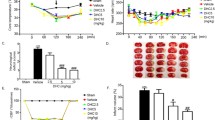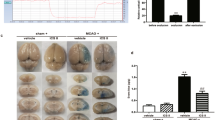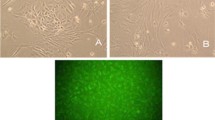Abstract
Magnolol, a neolignan compound isolated from traditional Chinese medicine Magnolia officinalis, has a potentially therapeutic influence on ischemic stroke. Previous studies have demonstrated that cerebral ischemia-reperfusion (I-R) and blood–brain barrier (BBB) are involved in the pathogeneses of stroke. Therefore, in vivo and in vitro studies were designed to investigate the effects of magnolol on I-R-induced neural injury and BBB dysfunction. In cerebral I-R model of mice, cerebral infarct volumes, brain water content, and the exudation of Evans blue were significantly reduced by intravenous injection with magnolol at the doses of 1.4, 7.0, and 35.0 μg/kg. When primary cultured microglial cells were treated with 1 μg/ml lipopolysaccharide (LPS) plus increasing concentrations of magnolol, ranging from 0.01 to 10 μmol/L, magnolol could statistically inhibit LPS-induced NO release, TNF-α secretion, and expression of p65 subunit of NF-κB in the nucleus of microglial cells. In the media of brain microvascular endothelial cells (BMECs), oxygen and glucose deprivation-reperfusion (OGD-R) could remarkably lead to the elevation of TNF-α and IL-1β levels, while magnolol evidently reversed these effects. In BBB model in vitro, magnolol dose- and time-dependently declined BBB hyperpermeability induced by oxygen and glucose deprivation (OGD), OGD-R, and ephrin-A1 treatment. More importantly, magnolol could obviously inhibit phosphorylation of EphA2 (p-EphA2) not only in ephrin-A1-treated BMECs but also in cerebral I-R model of mice. In contrast to p-EphA2, magnolol significantly increased ZO-1 and occludin levels in BMECs subjected to OGD. Taken together, magnolol can protect neural damage from cerebral ischemia- and OGD-reperfusion, which may be associated with suppressing cerebral inflammation and improving BBB function.








Similar content being viewed by others
References
Bederson JB, Pitts LH, Germano SM, Nishimura MC, Davis RL, Bartkowski HM (1986) Evaluation of 2, 3, 5-Triphenyltetrazolium chloride as a stain for Detection and quantification of experimental cerebral infarction in rats. Stroke 17:1304–1308
Bu Q, Liu X, Zhu Y, Liu Y, Wang Y (2014) w007B protects brain against ischemia-reperfusion injury in rats through inhibiting inflammation, apoptosis and autophagy. Brain Res 1558:100–108
Chang CP, Hsu YC, Lin MT (2003) Magnolol protects against cerebral ischaemic injury of rat heatstroke. Clin Exp Pharmacol Physiol 30:387–392
Chen HY, Hung YC, Lee EJ, Chen TY, Chuang IC, Wu TS (2009) The protective efficacy of magnolol in hind limb ischemia-reperfusion injury. Phytomedicine 16:976–981
Choi YK, Kim KW (2008) Blood-neural barrier: its diversity and coordinated cell-to-cell communication. BMB Rep 41:345–352
Chouchani ET, Pell VR, James AM, Work LM, Saeb-Parsy K, Frezza C, Krieg T, Murphy MP (2016) A unifying mechanism for mitochondrial superoxide production during ischemia-reperfusion injury. Cell Metab 23:254–263
Coulthard MG, Morgan M, Woodruff TM, Arumugam TV, Taylor SM, Carpenter TC, Lackmann M, Boyd AW (2012) Eph/Ephrin signaling in injury and inflammation. Am J Pathol 181:1493–1503
Dong L, Zhou S, Yang X, Chen Q, He Y, Huang W (2013) Magnolol protects against oxidative stress-mediated neural cell damage by modulating mitochondrial dysfunction and PI3K/Akt signaling. J Mol Neurosci 50:469–481
Drose S, Stepanova A, Galkin A (2016) Ischemic a/D transition of mitochondrial complex I and its role in ROS generation. Biochim Biophys Acta 1857:946–957
Dziedzic T (2015) Systemic inflammation as a therapeutic target in acute ischemic stroke. Expert Rev Neurother 15:523–531
Ikeda T, Xia YX, Kaneko M, Sameshima H, Ikenoue T (2002) Effect of the free radical scavenger, 3-methyl-1-phenyl-2-pyrazolin-5-one (MCI-186), on hypoxia-ischemia-induced brain injury in neonatal rats. Neurosci Lett 329:33–36
Ji K, Xue L, Cheng J, Bai Y (2016) Preconditioning of H2S inhalation protects against cerebral ischemia/reperfusion injury by induction of HSP70 through PI3K/Akt/Nrf2 pathway. Brain Res Bull 121:68–74
Jiao H, Wang Z, Liu Y, Wang P, Xue Y (2011) Specific role of tight junction proteins claudin-5, occludin, and ZO-1 of the blood-brain barrier in a focal cerebral ischemic insult. J Mol Neurosci 44:130–139
Kuo DH, Lai YS, Lo CY, Cheng AC, Wu H, Pan MH (2010) Inhibitory effect of magnolol on TPA-induced skin inflammation and tumor promotion in mice. J Agric Food Chem 58:5777–5783
Lee MM, Hseih MT, Kuo JS, Yeh FT, Huang HM (1998) Magnolol protects cortical neuronal cells from chemical hypoxia in rats. Neuroreport 9:3451–3456
Liang CJ, Lee CW, Sung HC, Chen YH, Wang SH, Wu PJ, Chiang YC, Tsai JS, Wu CC, Li CY, Chen YL (2014) Magnolol reduced TNF-alpha-induced vascular cell adhesion molecule-1 expression in endothelial cells via JNK/p38 and NF-kappaB signaling pathways. Am J Chin Med 42:619–637
Liu T, Zhang T, Yu H, Shen H, Xia W (2014) Adjudin protects against cerebral ischemia reperfusion injury by inhibition of neuroinflammation and blood-brain barrier disruption. J Neuroinflammation 11:107
Massey AJ (2015) Multiparametric cell cycle analysis using the operetta high-content imager and harmony software with PhenoLOGIC. PLoS One 10:e0134306
McColl BW, Rothwell NJ, Allan SM (2008) Systemic inflammation alters the kinetics of cerebrovascular tight junction disruption after experimental stroke in mice. J Neurosci 28:9451–9462
Moritz M, Pfeifer S, Balmayor ER, Mittermayr R, Wolbank S, Redl H, van Griensven M. (2016) VEGF released from a fibrin biomatrix increases VEGFR-2 expression and improves early outcome after ischaemia-reperfusion injury. J Tissue Eng Regen Med.
Moskowitz MA, Lo EH, Iadecola C (2010) The science of stroke: mechanisms in search of treatments. Neuron 67:181–198
Murakami K, Nakamura Y, Yoneda Y (2003) Potentiation by ATP of lipopolysaccharide-stimulated nitric oxide production in cultured astrocytes. Neuroscience 117:37–42
Nakagawa S, Deli MA, Kawaguchi H, Shimizudani T, Shimono T, Kittel A, Tanaka K, Niwa M (2009) A new blood-brain barrier model using primary rat brain endothelial cells, pericytes and astrocytes. Neurochem Int 54:253–263
Schaller B, Graf R (2004) Cerebral ischemia and reperfusion: the pathophysiologic concept as a basis for clinical therapy. J Cereb Blood Flow Metab 24:351–371
Sladojevic N, Stamatovic SM, Keep RF, Grailer JJ, Sarma JV, Ward PA, Andjelkovic AV (2014) Inhibition of junctional adhesion molecule-a/LFA interaction attenuates leukocyte trafficking and inflammation in brain ischemia/reperfusion injury. Neurobiol Dis 67:57–70
Szigeti K, Horvath I, Veres DS, Martinecz B, Lenart N, Kovacs N, Bakcsa E, Marta A, Semjeni M, Mathe D, Denes A (2015) A novel SPECT-based approach reveals early mechanisms of central and peripheral inflammation after cerebral ischemia. J Cereb Blood Flow Metab 35:1921–1929
Tatlisumak T, Carano RA, Takano K, Opgenorth TJ, Sotak CH, Fisher M (1998) A novel endothelin antagonist, A-127722, attenuates ischemic lesion size in rats with temporary middle cerebral artery occlusion: a diffusion and perfusion MRI study. Stroke 29:850–857 discussion 857-858
Thundyil J, Manzanero S, Pavlovski D, Cully TR, Lok KZ, Widiapradja A, Chunduri P, Jo DG, Naruse C, Asano M, Launikonis BS, Sobey CG, Coulthard MG, Arumugam TV (2013) Evidence that the EphA2 receptor exacerbates ischemic brain injury. PLoS One 8:e53528
White BC, Sullivan JM, DeGracia DJ, O'Neil BJ, Neumar RW, Grossman LI, Rafols JA, Krause GS (2000) Brain ischemia and reperfusion: molecular mechanisms of neuronal injury. J Neurol Sci 179:1–33
Widiapradja A, Santro T, Basta M, Sobey CG, Manzanero S, Arumugam TV (2014) Intravenous immunoglobulin (IVIg) provides protection against endothelial cell dysfunction and death in ischemic stroke. Exp Transl Stroke Med 6:7
Wilms H, Schwabedissen B, Sievers J, Lucius R (2009) Erythropoietin does not attenuate cytokine production and inflammation in microglia--implications for the neuroprotective effect of erythropoietin in neurological diseases. J Neuroimmunol 212:106–111
Yang TC, Zhang SW, Sun LN, Wang H, Ren AM (2008) Magnolol attenuates sepsis-induced gastrointestinal dysmotility in rats by modulating inflammatory mediators. World J Gastroenterol 14:7353–7360
Zhang G, Chen L, Yang L, Hua X, Zhou B, Miao Z, Li J, Hu H, Namaka M, Kong J, Xu X (2015) Combined use of spatial restraint stress and middle cerebral artery occlusion is a novel model of post-stroke depression in mice. Sci Rep 5:16751
Zhou N, Zhao WD, Liu DX, Liang Y, Fang WG, Li B, Chen YH (2011) Inactivation of EphA2 promotes tight junction formation and impairs angiogenesis in brain endothelial cells. Microvasc Res 82:113–121
Zhou T, Zhao L, Zhan R, He Q, Tong Y, Tian X, Wang H, Zhang T, Fu Y, Sun Y, Xu F, Guo X, Fan D, Han H, Chui D (2014) Blood-brain barrier dysfunction in mice induced by lipopolysaccharide is attenuated by dapsone. Biochem Biophys Res Commun 453:419–424
Acknowledgements
This work was supported by National Natural Science Foundation of China (81503060).
Author information
Authors and Affiliations
Corresponding author
Rights and permissions
About this article
Cite this article
Liu, X., Chen, X., Zhu, Y. et al. Effect of magnolol on cerebral injury and blood brain barrier dysfunction induced by ischemia-reperfusion in vivo and in vitro. Metab Brain Dis 32, 1109–1118 (2017). https://doi.org/10.1007/s11011-017-0004-6
Received:
Accepted:
Published:
Issue Date:
DOI: https://doi.org/10.1007/s11011-017-0004-6




